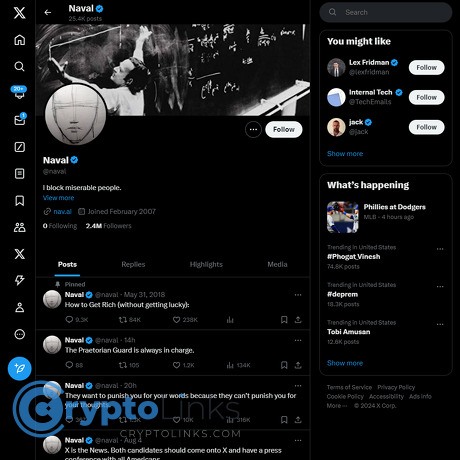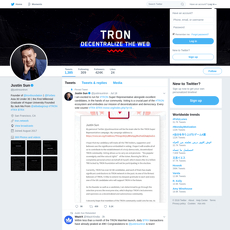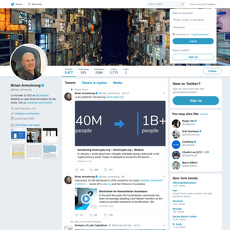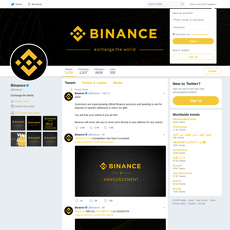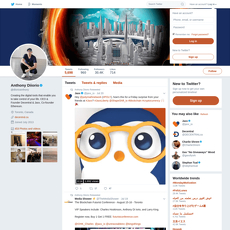Naval Review
Naval
x.com
Naval review guide: everything you need to know + FAQ
Is following Naval on X actually worth your time—especially for crypto?
If you’re like most people, your feed is a mess. Quote spam. “Wisdom” threads that aren’t his. Screenshots stripped of context. And when you finally reach the real account, it’s hard to tell how much of it helps you make better decisions about Bitcoin, Ethereum, or building in crypto.
On Cryptolinks.com, I cut through hype to focus on what moves the needle. This guide will help you decide if x.com/naval belongs in your daily signal feed, how to turn his posts into practical value, and what to avoid so you don’t waste attention.
Describe problems or pain
Here’s why most people don’t get much out of following big accounts like Naval—especially for crypto:
- Quote farms clutter your feed: Accounts repost the same punchy lines for likes, with no source or context. You get dopamine, not decisions.
- Impostors mimic the style: Threads start with “1/” and use his photo, but the handle is off. Many of these push engagement bait or even scams.
- Missed nuance: Screenshots travel farther than original posts, chopping out the reply chain where the real insight lives.
- Crypto frequency mismatch: Naval isn’t a daily market ticker. If you expect constant altcoin chatter, you’ll think he’s “not into crypto” when in fact he posts in high-signal bursts.
- Algorithm drift: Even if you follow the real account, X may bury posts unless you set it up right.
This matters. False or context-free content spreads faster than real analysis on social platforms (Science, 2018). And in markets, attention gets pulled toward flashy noise—shaping buys and sells in ways that don’t help you (Barber & Odean). Your edge is your attention. Protect it.
Signal beats frequency. Principles > price calls. That’s the angle to read Naval through.
Promise solution
Here’s the plan: I’ll show you who Naval is (through a crypto lens), what he actually posts about, how to build a smart follow setup, where to find his best work fast, and how to avoid impostors and misquotes. I’ll also answer the most common questions so you leave with a simple system, not a pile of tabs.
What you’ll get from this guide
- Clarity: What Naval really believes about Bitcoin, Ethereum, and decentralization.
- Practical setup: A simple follow-and-filter method so you only see high-signal posts.
- Fast discovery: Search strings and filters to surface his best threads in seconds.
- Safety checks: How to spot impostors, AI-fabricated threads, and misquotes.
- Action loop: A lightweight way to turn ideas into decisions.
Quick expectations
- Not a daily trading feed.
- Yes to frameworks, mental models, and long-term alignment with open networks.
- Occasional crypto bursts that age better than hot takes.
Who this is for
- Crypto‑curious investors who want principles they can apply across cycles.
- Builders and founders who value clear thinking over noise.
- Anyone curating a small, high-signal X List—less scrolling, better decisions.
What you won’t find here
- No hero worship or fluff.
- No altcoin “next 100x” calls or daily level updates.
- No recycled quotes without source links.
If you’re here for clear thinking on crypto, wealth, and decision‑making—and you want to turn a popular account into real value instead of random quotes—you’re in the right place.
So, who is Naval and why does crypto care about his voice in the first place? Let’s sort that out next—want the quick bio and why his takes keep getting amplified?
Who Naval is and why crypto people care
Naval Ravikant is the rare mix of founder, investor, and clear thinker who can compress complex ideas into a sentence you’ll remember in a bear market. He co-founded AngelList, backed dozens of successful startups, and built a reputation for practical wisdom that translates directly into how you think about crypto risk, timing, and skin-in-the-game.
“Play long-term games with long-term people.”
That line isn’t just motivational wallpaper. It’s a north star for crypto—open networks, aligned incentives, and compounding advantage over years, not weeks.
Quick bio and credibility
- Builder at scale: Co-founded AngelList, a platform that reshaped how startups raise and how investors discover talent and signal. That lens—matching founders and capital—shows up in how he talks about open protocols and permissionless innovation.
- Angel track record: Early investor in multiple category leaders across consumer, fintech, and infrastructure. The specific logos matter less than the pattern: he spots durable trends before they go mainstream.
- Clarity as a skill: His most known work, like How to Get Rich (without getting lucky), is about leverage, judgment, and accountability. Those ideas map 1:1 to crypto where code, capital, and community are the levers.
Why this credibility matters for crypto: he focuses on incentives and systems, not shiny objects. That’s the mindset that helps you survive volatility and avoid narrative traps.
What he actually tweets about
If you expect nonstop token chatter, you’ll be disappointed. If you want mental models that make you a better builder or investor, you’ll probably stick around.
- Philosophy and mental models: Short lines about judgment, leverage, and time. Useful when markets swing and you need principles more than predictions.
- Tech and AI: Takes on how new platforms change power structures—relevant to crypto’s push for open networks.
- Crypto (occasional, high signal): Comments on Bitcoin as hard money, interest in Ethereum and open protocols, and skepticism toward hype cycles and short-term trading.
In practice, you’ll see a handful of crypto posts across months, not daily threads. But when they land, they tend to age better than most cycle takes.
Know what you’re following him for
- Frameworks over forecasts: Think “what game am I playing?” and “which incentives matter here?” not “what’s the next alt to pump?”
- Low noise, high intent: Posts are sparse and specific. That’s a feature, not a bug.
- Decision hygiene: His guidance pairs well with research showing that excessive trading hurts returns. For example, Barber and Odean’s classic study found that high-turnover investors underperform due to overconfidence and fees (SSRN).
Put simply: his feed is for sharpening judgment, not chasing candles.
Is he worth following if I’m here only for crypto?
Yes—if you want principles that compound. His lens on sovereignty, skin-in-the-game, and long-term alignment will make you better at filtering narratives and sizing risk. If you need hourly market updates, on-chain alerts, or alt rotation calls, pair him with specialized accounts. But keep him in your signal pack for the ideas that keep you from making costly, emotional mistakes when volatility hits.
In the heat of a bull run, one line can save you from a bad click. In a bear, one framework can keep you building. That’s the real value.
Curious how those principles show up in his actual crypto takes—Bitcoin vs. Ethereum, decentralization, and what’s aged well (and what hasn’t)? Let’s look at that next.
Naval on crypto: themes, accuracy, and what to expect
When Naval talks crypto, the thread usually pulls on the same rope: decentralization, personal sovereignty, and simple bets that survive time. It’s not trade chatter. It’s a way to think, so you don’t get tossed around by every pump and headline.
Core views you’ll see
- Bitcoin as hard money: Expect strong support for Bitcoin’s scarcity and neutrality. The lens is long-term: a non-sovereign store of value, self-custody, and antifragility over convenience.
- Ethereum and open protocols: Interest in programmable money and permissionless innovation. He treats smart contracts and open standards as the backbone for new coordination tools, not just speculation.
- Skin in the game, low noise: Bias toward owning a few high-quality assets you deeply understand, holding your own keys, and avoiding leverage-fueled FOMO. Behavioral edges > hot tips.
- Skepticism of hype cycles: He doesn’t chase micro-cap narratives. If anything, he’ll nudge you to zoom out and watch which primitives keep working after the mania fades.
“Play long-term games with long-term people.”
That one line captures his crypto stance. In practice: favor assets and builders with Lindy—things that survive and compound. If it only works while everyone’s excited, it probably won’t age well. If it works because the incentives are sound, it likely will.
How often he talks crypto
Naval posts in waves. You might see quiet weeks and then a short run of high-signal posts during a key moment (policy, a protocol milestone, a major failure that proves a principle). If you’re looking for daily charts, this isn’t it. If you’re collecting mental models that outlast cycles, you’ll get value.
What aged well vs. not so much
- Aged well: Bitcoin as a durable store of value. His “hard money” framing keeps earning confirmations. Institutional adoption accelerated in 2024 with the approval of U.S. spot Bitcoin ETFs, a structural shift that validated the asset’s staying power.
- Aged well: Self-custody and sovereignty. The “not your keys, not your coins” principle is no longer theoretical. Centralized blowups (think FTX’s collapse in 2022) proved the risk of outsourcing custody (timeline; overview).
- Aged well: Avoiding churn and overtrading. Behavioral research backs this up. Individual investors who trade more tend to earn less—classic findings from Barber & Odean (SSRN) and DALBAR’s multi-decade studies on the cost of poor timing (QAIB).
- Less useful: Any short-cycle commentary. Price talk and narrative-of-the-month takes don’t age well—for anyone. Naval rarely engages there, and when he does, those posts are the first to expire.
Treat it as a compass, not a map
Here’s how his crypto lens translates into practical bearings you can apply without needing constant posts:
- Time horizon: Multi-year, not multi-day. Let compounding and Lindy work in your favor (Lindy effect).
- Asset quality: Prefer simple, credible primitives (e.g., proven monetary or compute layers) over complex tokenomics that need perfect conditions.
- Custody first: Understand wallets, backups, and operational security before increasing exposure.
- Noise filter: If an idea only makes sense inside a hype bubble, it’s probably not a core position.
Why this resonates for crypto people
Crypto attracts optimists and tinkerers—but it also punishes impatience. Naval’s angle is a reminder to build and hold around first principles: scarcity, censorship resistance, permissionless access. If you’ve ever felt whipsawed by the cycle, this mindset is a pressure release valve.
If you’re overwhelmed by charts and new tokens every week, breathe. A few strong principles can beat a thousand weak signals.
What not to expect
- No step-by-step trading setups, no “buy this alt on Tuesday.”
- No daily market commentary or on-chain dashboards.
- No spoon-fed narratives to chase. You’ll get frameworks, not FOMO fuel.
Where his frame aligns with the data
- Patience pays: Overtrading is reliably harmful to returns (Barber & Odean; DALBAR).
- Simple beats complex under stress: In high-volatility drawdowns, assets and systems built on clear, minimal assumptions tend to fail less catastrophically than ones with tangled dependencies.
- Custody risk is real: Centralized failure events have been the biggest cause of permanent loss for retail—not protocol-level failures. That’s exactly why the “own your keys” principle endures.
Feeling the signal
When a post of his sticks, it’s usually because it reframes a decision you face: which assets to hold, how to size, when to ignore the crowd. That’s the quiet edge—judgment. And judgment scales.
Want to turn a few high-signal posts into consistent outcomes? Up next, I’ll show you how to surface his best crypto threads in seconds, set up smart alerts, and keep the quote-farms out of your feed. Ready to make your X feed work for you instead of against you?
How to get the most from
You don’t need more tweets. You need a system. Here’s how I turn following into actionable signal—so ideas turn into better crypto and life decisions, not more tabs.
“Play long‑term games with long‑term people.” — Naval
Set up alerts and lists
He doesn’t post constantly, which is perfect for notifications done right.
- Follow the verified account: x.com/naval.
- Tap the bell: choose All Posts if you want every rare drop; otherwise Highlights to keep it lean. He’s low-volume, so this won’t spam you.
- Create a “Signal” List: name it “Principles + Crypto.” Add Naval and a handful (5–15) of high-quality builders, researchers, and risk-aware investors. Keep it tight; more than ~20 and signal dilutes.
- Pin the List timeline: open the List, tap the three dots, choose Pin to Nav. Check this before your Home feed so you lead with signal, not trends.
- Optional (X Pro): add columns for:
- from:naval -filter:replies (original posts)
- from:naval filter:replies (his replies often hide gems)
- from:naval (bitcoin OR ethereum OR crypto) min_faves:200 (high-signal crypto)
Pro tip: Batching notifications reduces stress without hurting responsiveness. A UBC experiment found limiting notification checks to a few daily batches lowered stress and improved focus. Since Naval posts infrequently, you get the upside without the overload.
Find his best threads fast
Skip the scroll. Use targeted searches you can copy, paste, and reuse:
- Longer crypto posts:from:naval (thread OR “1/”) (bitcoin OR ethereum OR crypto OR “hard money”) min_faves:500
- Underrated replies:from:naval filter:replies (bitcoin OR ethereum OR web3) min_faves:50
- Evergreen principles:from:naval (“judgment” OR “leverage” OR “compounding”) min_faves:1000
- Older cycles (timebox it):from:naval (bitcoin OR crypto) since:2017-01-01 until:2021-01-01
- Linked essays/podcasts:from:naval (“podcast” OR “episode” OR url:nav.al)
- Pure originals (no RTs):from:naval -filter:replies -filter:retweets min_faves:1000
When you hit something useful, open the full thread, then the replies. Context is where application lives.
Filter noise
Your time is expensive. Treat it that way.
- Always click through: quote-farm screenshots strip context and often tweak wording for engagement. Open the original post before you save or share.
- Use mute strategically: mute phrases that clutter your feed like “Thread”, “1/”, and “Retweet to win”. It’s amazing how much fake wisdom disappears.
- Tune search to authenticity: when browsing, add -filter:retweets to cut recycled content.
- Prune your List monthly: if an account hasn’t improved a decision in 30 days, remove it. Entertainment goes to Home; signal stays on the List.
Remember: if a post can’t change a decision, it’s content—not signal.
Bookmark and tag by theme
Great ideas decay if you don’t stage them for reuse. Build a lightweight library:
- Bookmark with intent: if you have Bookmark Folders, tag by theme: crypto, mental models, investing, decision-making. If not, paste the link into a simple notes app or Notion with the same tags.
- Name it for recall: use a short prefix so you can search later, e.g., naval: hard money vs. fiat.
- Batch reviews: schedule a 15-minute “Signal Review” each week. Surface 5 saved posts and ask, “Does this change something I’m doing?”
Why this works: spaced retrieval beats re-reading. A large meta-analysis (Cepeda et al., Psychological Bulletin) shows spaced review dramatically improves long-term retention. Translation: tag now, remember later.
Build a learning loop
Insight is cheap. Behavior is rare. Turn each useful post into an action:
- One-line takeaway: “Bitcoin is the simplest hard-money bet; avoid complexity for status.”
- Implementation intention (backed by research from Gollwitzer): “If I feel FOMO on a new token, I will re-check my hard-money allocation first.”
- Next action: “Revisit BTC/ETH weighting on the first business day of next month.”
- Spaced check-ins: review the takeaway at 1, 3, 7, and 30 days. If it didn’t change behavior by day 7, it was inspiration, not instruction.
- Anchor the habit: “When I open X, I first open my Signal List and review 1 saved post—then I can browse.” Tiny Anchors = consistent execution.
That’s the whole point: fewer quotes, more decisions.
One more thing—what if the “Naval” tweet you loved wasn’t actually his, or the wording was AI-fluffed for likes? How do you spot impostors and misquotes before they waste your time? Let’s fix that next.
Safety check: impostors, misquotes, and context
Your attention is scarce, and crypto scammers know it. When a voice gets as big as Naval’s, copycats multiply, screenshots get weaponized, and “motivational” threads appear that he never wrote. Here’s how I keep my feed clean and my judgment intact.
Verify the real account
There’s only one handle you need to lock in: https://x.com/naval. Everything else is noise until proven otherwise.
- Handle over badge: A blue check can be purchased; the exact handle matters. Look for @naval, no underscores, no numbers, no extra letters.
- Cross-verify from his site: Naval links out from nav.al. If a profile claims to be him but isn’t linked there, I treat it as untrusted.
- Profile fingerprint: Long posting history, restrained bio, and minimal promotional links. Impostors often have recently created accounts and pin “airdrop” or “giveaway” posts.
Spot misquotes and AI-fabricated threads
Naval’s writing has a distinct fingerprint: short lines, first‑principles logic, very few emojis, and almost no fluff. If you see a 30‑tweet “hustle” chain with hashtags and motivational filler, it’s probably not him.
- Style tells: He uses crisp sentences and avoids hype words. Bloated “10 rules to get rich quick” threads are a red flag.
- Source test: Copy 6–10 words of the quote and search X: from:naval "exact phrase". No result? It’s likely a misquote or AI-generated paraphrase.
- Time check: If a supposed “new” quote links to an old screenshot with no original post, I assume it’s fabricated until I find the source.
Why be so strict? A large study in Science (MIT, 2018) found that false news spreads “farther, faster, deeper, and more broadly” than the truth on social networks. The faster a quote travels without a source, the more I distrust it.
“Play long‑term games with long‑term people.”
— Naval Ravikant
That line is real. It’s also one of the most hijacked. I always click through to the original before I save or share it.
Be careful with screenshots
Screenshots get cropped, reworded, and ripped out of context to push agendas or scams. I treat them as trailheads, not truth.
- Click through: If a screenshot cites @naval, I tap until I reach the @naval post. No source, no trust.
- Check replies: Naval’s best ideas often sit in a reply or a quote-tweet. The screenshot rarely includes that nuance.
- Watch for overlays: “Limited-time giveaway” banners on screenshots are almost always fake. Naval doesn’t run giveaways.
Context matters
Principles are durable; takes without context aren’t. Before I act on a punchy line, I make sure I know what it was responding to—and when.
- Date audit: A 2017 comment about Bitcoin’s role isn’t a 2025 trading signal. Timestamp first, reaction second.
- Thread position: Quote, scroll one up and one down. Many “hot takes” are actually clarifications or constraints.
- Link trail: If he links to a podcast or essay, I skim it. A 10‑minute listen saves months of confusion.
Red‑flag patterns I ignore instantly
- “Naval is giving away ETH/BTC” or “Claim airdrop” posts. Hard no.
- Telegram/WhatsApp DMs “from Naval.” He’s not DMing you for funds, ever.
- Handles like @navai, @naval_, @navaI (capital i), or random digits. Classic impersonation tricks.
- Pinned affiliate links to trading bots, AI token sales, or “secret wealth groups.” Not his style.
My quick “source or skip” checklist
- Handle verified: It’s from @naval.
- Original located: I can open the exact post, not just a screenshot.
- Style matches: Short, clear, principle‑driven writing—no emoji soup.
- Date + thread read: I checked the timestamp and at least one reply above/below.
- Links look right: Domains I expect: x.com/naval and nav.al. Everything else gets extra scrutiny.
If you spot an impostor
- Report: Use X’s “Report” > “Impersonation.” It actually helps shrink their reach.
- Mute/Block: Don’t feed the algo with angry replies; starve them of engagement.
- Reply with source (optional): When it’s worth it, I correct with a link to the real post—then mute the thread.
I think of this as basic wallet hygiene for attention: trust slowly, verify always, and never send “belief” to an address you didn’t double-check. Want the fast answers to the questions people keep asking about Naval—how often he posts, what he’s best for, and where to find the deeper material?
FAQ: what people usually ask about Naval
Who is Naval Ravikant?
He’s an entrepreneur and investor best known for co‑founding AngelList and for crisp writing on wealth, judgment, and technology. On X, his handle is the verified x.com/naval. His influence comes from spotting big shifts early, communicating clearly, and staying focused on first principles. That’s why crypto folks pay attention—he leans toward decentralization, personal sovereignty, and simple, durable bets like Bitcoin.
Is Naval a good source for crypto investing?
Yes—if you want principles and long‑term signal. No—if you want daily token calls or scalp trades.
Here’s why I rate him for crypto judgment: his guidance pushes you toward clarity, simplicity, and time‑tested ideas (e.g., self‑custody, avoiding hype cycles). There’s solid evidence that this mindset helps. In one famous study, researchers Barber and Odean found that frequent traders dramatically underperform the market (“Trading Is Hazardous to Your Wealth,” 2000). Naval’s approach nudges you away from impulsive churn and toward compounding knowledge—exactly what most investors need in a noisy crypto market.
Real example: during mania phases (think late‑cycle alt seasons), his stance to keep it simple and focus on durable networks would have saved you from a lot of rug pulls and FOMO churn. You won’t get coin picks; you’ll get the kind of thinking that keeps you solvent.
Does Naval still tweet? How often?
Yes, but irregularly. Expect bursts, then quiet stretches. When he posts about crypto (Bitcoin, Ethereum, open protocols), it tends to be high‑signal and evergreen rather than reactive to daily price action. If you want to catch those rare gems, use notifications (below) or add him to a high‑signal List so the algorithm doesn’t bury the good stuff.
How do I turn on notifications?
- Open x.com/naval
- Tap the bell icon on his profile
- Select All Posts (best for rare, high‑signal accounts)
Pro tip: also add him to a custom List called “Signal” so you have a dedicated feed that cuts through the main timeline noise.
Where can I find longer‑form content?
- Essays, transcripts, and podcast: nav.al
- The crowd‑favorite compilation of his ideas: The Almanack of Naval Ravikant
If you like his short posts on X, these resources give you the full context behind the one‑liners.
Who else should I follow if I like Naval?
Pair principles with data and builder POVs. A balanced starter set:
- @hasufl — crypto economics and research
- @nic__carter — Bitcoin, energy, policy
- @cdixon — builder‑oriented take on crypto + apps
- @LynAldenContact — macro frameworks that matter for Bitcoin
- @laurashin — long‑form interviews and investigations
- @MessariCrypto, @glassnode — research and on‑chain data
Keep it small and intentional. The goal is a high‑signal mix of principles, research, and on‑chain reality—not 200 follows you’ll never read.
Does Naval disclose his crypto holdings?
Not in a running, portfolio‑style way. He’s been openly supportive of Bitcoin and open networks, but he mostly shares principles, not allocations. That’s a feature, not a bug—you’re less likely to anchor on someone else’s bags.
Is he pro‑Bitcoin or pro‑Ethereum?
He’s consistently positive on Bitcoin as hard money and supportive of open protocols like Ethereum. The tone is long‑term and infrastructure‑focused, not chain tribalism. Expect “decentralization and sovereignty > hype and speculation.”
Are there impostor accounts I should avoid?
Yes. Stick to the verified handle: x.com/naval. Quote‑farm accounts often remix his lines into bloated motivational threads. When in doubt, click through to the source or check his essays at nav.al for the original context.
How do I get fast value from his posts?
- When a post clicks, write a one‑line takeaway and a next action (e.g., “Self‑custody review this weekend”).
- Save it to a “Signal” folder and tag by theme: crypto, mental models, investing.
- Review your tags monthly and ship one small decision each week.
This turns inspiration into compounding behavior—where all the real ROI is.
Should I read his replies or just the main posts?
Scan replies when the thread is technical or subtle—context often lives there. You’ll sometimes see high‑quality follow‑ups from builders and researchers that sharpen the original point. If it’s motivational or timeless, the main post usually stands alone.
Ready for the punchline? Next up, I’ll tell you exactly whether x.com/naval deserves a spot in your daily feed—and share a 60‑second setup to capture his signal without drowning in noise. Want the simple checklist I use?
My verdict: should you follow x.com/naval?
If you want clearer thinking and steadier hands in crypto, follow x.com/naval. Not for tick-by-tick market updates—he’s not that guy—but for the kind of principles that help you avoid dumb risks, spot durable trends, and make fewer, better decisions. Treat his feed like a mental upgrade, not a trade alert.
Here’s why I’m confident in that call: the high-return moves in crypto usually come from patience, simplicity, and avoiding churn. That’s right in his wheelhouse. Academic work backs this up. Barber and Odean’s “Trading Is Hazardous to Your Wealth” found that frequent traders materially underperform less active investors—mainly due to overconfidence and excessive churn. DALBAR’s long-running QAIB reports show a persistent “behavior gap” where many investors underperform their own funds because they chase and panic. A feed that nudges you toward first principles and away from FOMO is an edge.
Best for
- Long-term crypto investors who value simple, robust theses over short-lived narratives.
- Founders and builders who want clarity on incentives, decentralization, and product thinking.
- Researchers and curators assembling a small, high-signal corner of X for ongoing learning.
- Anyone optimizing decision quality—fewer impulsive moves, more compounding knowledge.
Not ideal for
- Short-term traders who need daily levels, alt rotations, or rapid on-chain alerts.
- Headline hunters expecting nonstop news or token-specific commentary.
- People who want step-by-step instructions rather than frameworks and hard-earned heuristics.
Simple setup that works
- Follow + bell on: Hit the bell on his profile so you catch rare high-signal posts when they land.
- Put him in a “Signal” List: One tight List with 10–20 thinkers. Here’s how to use Lists if you need it: Twitter/X Lists guide.
- Cut the clutter: From the three-dot menu on his profile, choose Turn off Retweets to keep your feed focused. Do this for other loud accounts too.
- Save and tag: Bookmark his most useful posts and tag them in your notes app by theme—crypto, mental models, investing rules. Re-reading beats re-scrolling.
- Monthly mini-review (15 minutes): Revisit 3 saved posts, write one sentence on how it applies to your portfolio or company, and pick one small action.
- One idea per week, applied:
- Reduce complexity: Trim a sprawl of 20 tokens down to 5 highest conviction positions.
- Own, don’t rent: Move a set percentage into self-custody and document your recovery steps.
- Skin in the game: Before any new bet, write a 5-line pre-mortem. If it feels flimsy on paper, skip it.
Why this setup works: platforms reward speed; results reward patience. You’re designing a feed that promotes calm, simple, compounding moves—the behaviors backed by evidence to outperform busywork.
Bottom line
Follow him. Think of his feed as a compass, not a map—it won’t tell you which token to buy on Tuesday, but it will keep you pointed toward first principles and away from self-sabotage. Set notifications, add him to a clean “Signal” List, save the posts that matter, and apply one idea each week. That’s how you turn a social follow into better crypto decisions—and more time back in your day.
CryptoLinks.com does not endorse, promote, or associate with Twitter accounts that offer or imply unrealistic returns through potentially unethical practices. Our mission remains to guide the community toward safe, informed, and ethical participation in the cryptocurrency space. We urge our readers and the wider crypto community to remain vigilant, to conduct thorough research, and to always consider the broader implications of their investment choices.

